Related Research Articles

A frigate is a type of warship. In different eras, the roles and capabilities of ships classified as frigates have varied greatly.
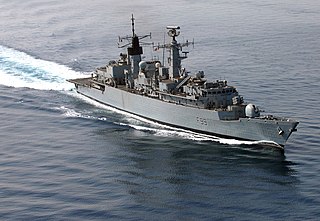
The Type 22 frigate also known as the Broadsword class was a class of frigates built for the British Royal Navy. Fourteen were built in total, with production divided into three batches.

The County class was a class of British guided missile destroyers, the first such warships built by the Royal Navy. Designed specifically around the Seaslug anti-aircraft missile system, the primary role of these ships was area air defence around the aircraft carrier task force in the nuclear-war environment.

The Type 21 frigate, or Amazon-class frigate, was a British Royal Navy general-purpose escort that was designed in the late 1960s, built in the 1970s and served throughout the 1980s into the 1990s.

The Type 81, or Tribal class, frigates were ordered and built as sloops to carry out similar duties to the immediate post war improved Black Swan-class sloops and Loch-class frigates in the Persian Gulf. In the mid 1960s the seven Tribals were reclassified as second class general-purpose frigates to maintain frigate numbers. After the British withdrawal from East of Suez in 1971 the Tribals operated in the NATO North Atlantic sphere with the only update the fitting of Seacat missiles to all by 1977, limited by their single propeller and low speed of 24 knots. In 1979-80 age and crew and fuel shortages saw them transferred to the stand-by squadrons; three were reactivated in 1982 during the Falklands War for training and guardship duties in the West Indies.
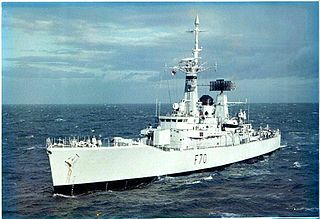
The Leander-class, or Type 12I (Improved) frigates, comprising twenty-six vessels, was among the most numerous and long-lived classes of frigate in the Royal Navy's modern history. The class was built in three batches between 1959 and 1973. It had an unusually high public profile, due to the popular BBC television drama series Warship. The Leander silhouette became synonymous with the Royal Navy through the 1960s until the 1980s.

The Type 12 or Whitby-class frigates were a six-ship class of anti-submarine frigates of the Royal Navy, which entered service late in the 1950s. They were designed in the early 1950s as first-rate ocean-going convoy escorts, in the light of experience gained during World War II. At this time, the Royal Navy were designing single-role escorts and the Whitbys were designed as fast convoy escorts capable of tackling high-speed submarines. However, this made the Whitbys more expensive and sophisticated to produce in large numbers in the event of a major war, and so the Type 14 "utility" or "second-rate" anti-submarine frigate was developed to complement the Type 12. Although themselves rapidly outdated, the Type 12 proved to be an excellent basis for a series of frigate designs used by the British and Commonwealth navies for the next 20 years.

HMS Ajax was a Leander-class frigate of the Royal Navy. She was built by the famous Cammell Laird company of Birkenhead. Ajax was launched on 16 August 1962 and commissioned on 10 December 1963. She was originally intended to be named HMS Fowey, and laid down as a Rothesay class, but instead became part of Batch 1 of the Leander class.

HMS Dido was a Royal Navy (RN) Leander-class frigate. Entering service in 1961, Dido was involved in the Indonesia–Malaysia confrontation, served with NATO's Standing Naval Force Atlantic on several occasions, and was one of the frigates used for the filming of the drama series Warship.
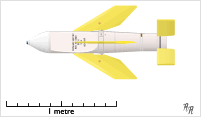
Seacat was a British short-range surface-to-air missile system intended to replace the ubiquitous Bofors 40 mm gun aboard warships of all sizes. It was the world's first operational shipboard point-defence missile system, and was designed so that the Bofors guns could be replaced with minimum modification to the recipient vessel and (originally) using existing fire-control systems. A mobile land-based version of the system was known as Tigercat.
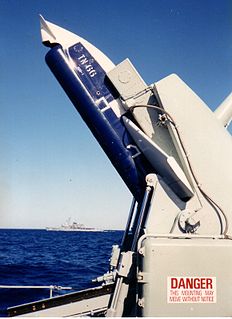
The Ikara missile was an Australian ship-launched anti-submarine missile, named after an Australian Aboriginal word for "throwing stick". It launched an acoustic torpedo to a range of 10 nautical miles (19 km), allowing fast-reaction attacks against submarines at ranges that would otherwise require the launching ship to close for attack, placing itself at risk. By flying to a distant target, the engagement time was dramatically shorter than provided by short-range weapons, giving the target less time to respond.

The Anzac class is a ship class of ten frigates; eight operated by the Royal Australian Navy (RAN) and two operated by the Royal New Zealand Navy (RNZN). During the 1980s, the RAN began plans to replace the River-class destroyer escorts with a mid-capability patrol frigate, and settled on the idea of modifying a proven German design for Australian conditions. Around the same time, the RNZN was seeking to replace their Leander-class frigates while maintaining blue-water capabilities. A souring of relations between New Zealand and the United States of America in relation to New Zealand's nuclear-free zone and the ANZUS security treaty prompted New Zealand to seek improved ties with other nations, particularly Australia. As both nations were seeking warships of similar capabilities, the decision was made in 1987 to collaborate on their acquisition. The project name is taken from the Australian and New Zealand Army Corps of the First World War.

The River class was a class of six destroyer escorts operated by the Royal Australian Navy (RAN). Plans to acquire four vessels, based on the British Type 12M frigate, began in the 1950s. The first two vessels had some slight modifications to the design, while the next two underwent further changes. Two more ships were ordered in 1964, following the Melbourne-Voyager collision; these were based on the Type 12I frigate.
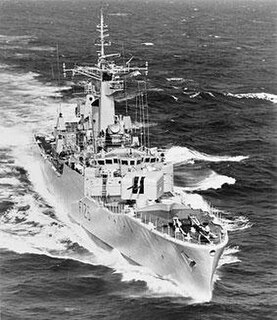
The Rothesay class, or Type 12M frigates were a class of frigates serving with the Royal Navy, South African Navy and the Royal New Zealand Navy.
The Type system is a classification system used by the British Royal Navy to classify surface escorts by function. The system evolved in the early 1950s, when the Royal Navy was experimenting with building single-purpose escort vessels with specific roles in light of experience gained in World War II. The original numbering scheme was:

HMNZS Otago (F111) was a Rothesay-class frigate acquired from the United Kingdom by the Royal New Zealand Navy (RNZN) before completion.
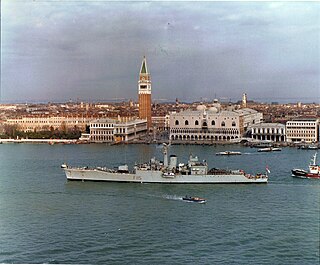
HMS Berwick was a Rothesay- or Type 12I-class anti-submarine frigate of the British Royal Navy. She was built by Harland & Wolff and launched on 15 December 1959.
HMNZS Waikato (F55) was a Leander Batch 2TA frigate of the Royal New Zealand Navy (RNZN). She was one of two Leanders built for the RNZN, the other being the Batch 3 HMNZS Canterbury. These two New Zealand ships relieved British ships of the Armilla patrol during the Falklands conflict, freeing British ships for deployment.

The Nilgiri-class frigates, formally classified as the Project-17 Alpha frigates (P-17A), are a series of guided-missile frigates currently being built by Mazagon Dock Shipbuilders (MDL) and Garden Reach Shipbuilders & Engineers (GRSE), for the Indian Navy.
References
- Marriott,Leo, 'Royal Navy Frigates Since 1945', Second Edition, ISBN 0-7110-1915-0, Published by Ian Allan Ltd (Surrey, UK), 1990
- Purvis,M.K., 'Post War RN Frigate and Guided Missile Destroyer Design 1944-1969', Transactions, Royal Institution of Naval Architects (RINA), 1974
- Jeremy, John C. (2005). "Australian shipbuilding and the impact of World War II". In Stevens, David; Reeve, John (eds.). The Navy and the Nation: the influence of the Navy on modern Australia . Crows Nest, NSW: Allen & Unwin. pp. 196–8. ISBN 1-74114-200-8. OCLC 67872922.